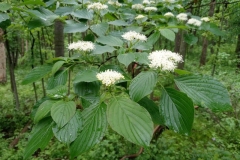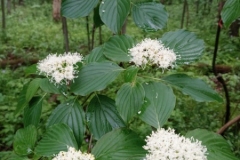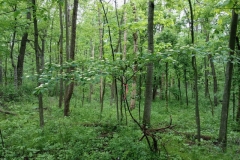alternateleaf dogwood
Cornus alternifolia
Other Common Names:
flowering dogwood, alternate-leaved dogwood, pagoda dogwood
Description:
Alternateleaf dogwood is an understory dominant in the northeastern United States and in the sugar maple (Acer saccharum) forest of the Great Lakes region.
Common associates of alternateleaf dogwood include chokecherry (Prunus virginiana), American hazel (Corylus americana), hazelnut (C. cornuta), mountain maple (Acer spicatum), striped maple (A. pennsylvanicum), black cherry (Prunus serotina), serviceberry (Amelanchier canadensis), mountain-laurel (Kalmia latifolia), huckleberries (Vaccinium spp.), and dogwoods (Cornus spp.).
Locations:
Found in woodlands and woodland edges across Wisconsin. Wisflora Online Database has recorded specimens from all counties except, Green Lake, Monroe and Winnebago.
Impact:
At least 11 species of birds including ruffed grouse eat alternateleaf dogwood. Black bear also eat the fruit. The leaves and stems are eaten by white-tailed deer, cottontail rabbits, and beavers.
alternate leaf dogwood
| USDA Symbol: | Common Name: | Scientific Name: |
|---|---|---|
| COAL2 | alternateleaf dogwood | Cornus alternifolia |
ITIS TSN: 27813
Category: Dicot
Taxonomy
Kingdom: Plantae
Subkingdom:
Super Division: Spermatophyta
Division: Magnoliophyta
Subdivision:
Class: Magnoliopsida
SubClass: Rosidae
Order: Cornales
Family: Cornaceae
Counties: Adams, Ashland, Barron, Bayfield, Brown, Buffalo, Burnett, Calumet, Chippewa, Clark, Columbia, Crawford, Dane, Dodge, Door, Douglas, Dunn, Eau Claire, Florence, Fond du Lac, Forest, Grant, Green, Iowa, Iron, Jackson, Jefferson, Juneau, Kenosha, Kewaunee, La Crosse, Lafayette, Langlade, Lincoln, Manitowoc, Marathon, Marinette, Marquette, Menominee, Milwaukee, Oconto, Oneida, Outagamie, Ozaukee, Pepin, Pierce, Polk, Portage, Price, Racine, Richland, Rock, Rusk, Sauk, Sawyer, Shawano, Sheboygan, St. Croix, Taylor, Trempealeau, Vernon, Vilas, Walworth, Washburn, Washington, Waukesha, Waupaca, Waushara, Wood
| Duration: | Growth Habit: | Native Status: |
|---|---|---|
| Perennial | Tree, Shrub | L48(N)CAN(N)SPM(N) |
| NR40 Listed Plant | Noxious Weed: | Invasive Species (NR40): | Threatened/Endangered: | WI Natural Heritage Index: | Wetland Status |
|---|---|---|---|---|---|
| FAC;FACU |
Active Growth Period: Spring and Summer
Bloat: None
Carbon to Nitrogen Ratio: High
Coppice Potential: Yes
Conspicuous Fall Color: Yes
Fire Resistant: No
Flower Color: White
Conspicuous Flower: Yes
Foliage Color: Dark Green
Foliage Light Porosity Summer: Dense
Foliage Porosity Winter: Porous
Foliage Texture: Medium
Fruit/Seed Color: Black
Growth Form: Multiple Stems
Growth Rate: Moderate
Height at Base Age (Max): 25
Known Alelopath: No
Leaf Retention: No
Lifespan: Moderate
Re-sproutability: Yes
Shape and Orientation: Erect
Toxicity: None
Height (min):
Height (max): 360
Root Type:
Leaf Type:
Leaf Arrangement:
Vein Pattern:
Adapted to Coarse Textured Soils: No
Adapted to Medium Textured Soils: No
Adapted to Fine Textured Soils: Yes
Anaerobic Tolerance: None
CaCO3 Tolerance: Low
Cold Stratification Required: Yes
Drought Tolerance: Low
Fertility Requirement: Medium
_Fire Tolerance: Low
Hedge Tolerance: Low
Moisture Use: High
pH (Minimum): 4.8
pH (Maximum): 7.3
Planting Density per Acre, Minimum: 1200
Planting Density per Acre, Maximum: 1700
Precipitation (Minimum): 24
Precipitation (Maximum): 70
Root Depth, Minimum (inches): 20
Salinity Tolerance: None
Shade Tolerance: Tolerant
Temperature, Minimum (°F): -47
Plant Spacing (min):
Plant Spacing (max):
| Bloom Period: | Commercial Availability: | Fruit/Seed Abundance: |
|---|---|---|
| Mid Spring | No Known Source | Medium |
| Fruit/Seed Period Begin: | Fruit/Seed Period End: | Fruit/Seed Persistence: |
|---|---|---|
| Summer | Fall | Yes |
| Propogated by Bare Root: | Propogated by Bulbs: | Propogated by Container: |
|---|---|---|
| Yes | No | Yes |
| Propogated by Corms: | Propogated by Cuttings: | Propogated by Seed: |
|---|---|---|
| No | Yes | Yes |
| Propogated by Sod: | Propogated by Sprigs: | Propogated by Tubers: |
|---|---|---|
| No | No | No |
| Seeds per Pound: | Seed Spread Rate: | Seedling Vigor: |
|---|---|---|
| 8000 | Slow | Low |
| Small Grain: | Vegetative Spread Rate: | Propagation Treatment: |
|---|---|---|
| No | None |
| Days to Stratify: | Direct Sowing Time: |
|---|---|
| Bloom Period: | Commercial Availability: | Fruit/Seed Abundance: |
|---|---|---|
| Mid Spring | No Known Source | Medium |
| Fruit/Seed Period Begin: | Fruit/Seed Period End: | Fruit/Seed Persistence: |
|---|---|---|
| Summer | Fall | Yes |
| Propogated by Bare Root: | Propogated by Bulbs: | Propogated by Container: |
|---|---|---|
| Yes | No | Yes |
| Propogated by Corms: | Propogated by Cuttings: | Propogated by Seed: |
|---|---|---|
| No | Yes | Yes |
| Propogated by Sod: | Propogated by Sprigs: | Propogated by Tubers: |
|---|---|---|
| No | No | No |
| Seeds per Pound: | Seed Spread Rate: | Seedling Vigor: |
|---|---|---|
| 8000 | Slow | Low |
| Small Grain: | Vegetative Spread Rate: | Propagation Treatment: |
|---|---|---|
| No | None |
| Days to Stratify: | Direct Sowing Time: |
|---|---|
Click here for the Native Plants Page




